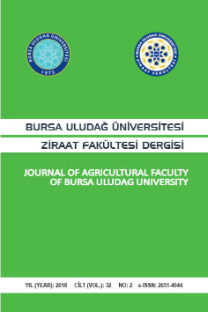Some fattening and slaughter characteristics of Holstein young bulls in intensive conditions
kesim ağırlığı, et randımanı, boğa, mevsimler, vücut ağırlığı, sığır, sığır ırkları, besi, canlı ağırlık artışı
Enstantif koşullardaki sayah alaça danaların bazı besi ve kesim özellikleri
slaughter weight, dressing percentage, bulls, seasons, body weight, cattle, cattle breeds, finishing, liveweight gain,
___
1. AKCAN A, ARPACIK R, GÜNEREN G, KARAGENÇ L. The effect of starting time on fattening performance in Holstein Bulls. J.of Lalahan Livestock Res.Inst. 1991; 31 (3-4): 9-16. 2. AKCAN A, GÜRDOĞAN T, ÇETIN İ. Effect of different final weight of Holstein young bulls on slaughter and carcass characteristics. J.of Lalahan Livestock Res.Inst. 1989; 29 (1-4): 21-36. 3. ALPAN O, ARPACIK R. Sığır Yetiştiriciliği. Şahin Matbaası, Ankara, 1996. 4. ALPAN O, ERTUĞRUL O, BAYRAKTAROĞLU E A. 2000’li yıllar ve Türkiye kırmızı et üretimi. 2000’lere Doğru Türkiye Hayvancılığı Kongresi, Ankara, 9-10 Haziran 1993, 27-48. 5. ARPACIK R, AKCAN A, ALPAN O, ERTUĞRUL O, AKSOY A R. The effect of initial weight on feedlot performance, slaughter and carcass characteristics in Holstein bulls. Ankara Üniv.Vet.Fak.Derg. 1988; 35 (1): 124-134. 6. ARPACIK R, NAZLIGÜL A, BEYHAN Z, ATASOY F. The effects of initial weight on fattening traits and economy of the enterprise in Turkish Brown bulls. J.of Lalahan Livestock Res.Inst. 1994; 34 (1-2): 79-89. 7. ARPACIK R. Entansif Sığır Besiciliği. Şahin Matbaası, Ankara 1999. 8. BAŞARAN A, AKCAN A. The effects of season on fattening performance, slaughter and carcass characteristics and feeding cost of Holstein bulls. J.of Lalahan Livestock Res.Inst. 1997; 37 (1): 20- 36. 9. BAŞPINAR H, OĞAN M, BALCI F. Fattening performance and carcass characteristics of Polish Holstein bulls. J.of Lalahan Livestock Res.Inst. 1999; 39 (2): 1-6. 10. DİE, http://www.die.gov.tr/IstTablolar/13ta177t.xls. 2000. 11. İLGÜ E, GÜNEŞ H. Studies on the feedlot performance of male Holstein-Friesian cattle under private farm conditions. J.Fac.Vet.Med.Univ.Istanbul. 2002; 28 (2): 313- 335. 12. KOÇAK D, COŞAR S, TULGAR N. Effects of different energy levels on feedlot fattening performance and carcass characteristics of Holstein bulls, in winter. J.of Lalahan Livestock Res.Inst. 1995; 35 (1-2): 1-20. 13. MORRISON S R. Ruminant heat stress; effect on production and means of alleniation. J.Anim.Sci. 1983; 57 (6): 1594-1600. 14. OĞAN M, BAŞPINAR B, BALCI F. The effect of starting season on fattening performance of Polish Holstein bulls. Uludağ Univ.J.Fac.Vet.Med. 1997; 1-2-3, (16): 49-55. 15. SCHAKE L M, ROBINSON G N, PHISTER R B. Influence of year and season on performance of cattle fed in confinement barns. Beef Cattle Research in Texas. 92-93, 1980. 16. SPSS 8.0. SPSS for Windows Advanced Statistic Release 8.0. 1997. 17. TÜZEMEN N, YANAR M, TELLİOĞLU S, EMSEN H. A comparative study on the fattening performances and carcass charateristics of Simmental, Holstein, Brown Swiss and Norvegian Red x Brown Swiss crossbred young bulls. Tr.J.of.Vet. and Anim. Sci. 1990; 14: 47-54. 18. YENER S M, AKMAN N. Türkiye’de sığırcılığın bugünü ve geleceği. T.O.K. Dergisi. 1990; 54, 6-9. 19. YOUNG B A. Ruminant cold stress; effect on production. J.Anim.Sci. 1983; 57 (6): 1601-1607.- ISSN: 1301-3173
- Yayın Aralığı: Yılda 2 Sayı
- Başlangıç: 1981
- Yayıncı: Ahmet Akkoç
Cryptosporidium parvum' un buluşmasında su ve gıdaların rolü
CENK AYDIN, Engin KENNERMAN, NURTEN GALİP, Murat YALÇIN, Füsun AK, Cüneyt KAYAALP
Yumurta tavuğu yemlerine klinoptilolit katkısının yumurta verimi ve kalitesine etkisi
Ş.Şule GEZEN, Faruk BALCI, Mustafa EREN, Fatih ORHAN
Tarımsal ve hayvansal ürünlerde modern biyoteknoloji ve organik üretim
Tam yağlı soyanın metabolik enerji değerinin broyler performansından tahmini
Nizamettin Şenköylü, Hasan AKYÜREK, H. Ersin ŞAMLI, AYLİN AĞMA OKUR
Levels of zinc, copper and magnesium in sheep with toxoplasmosis
Kamil SEYREK, SERDAR PAŞA, FUNDA KIRAL, AYŞEGÜL BİLDİK, Babür CAHİT, Selçuk KILIÇ
Şanlıurfa yöresinde koyun ve keçilerde bazı lentivirus enfeksiyonlarının araştırılması
